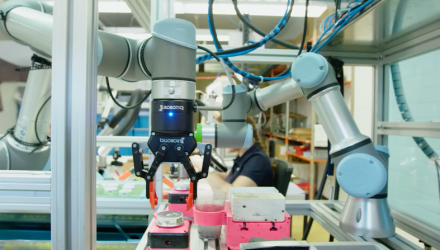Last year, a robot helped with a delicate eye surgery involving retinal growths for the first time. Doctors had previously done the procedure without automation, but that approach is risky, because even the blood pumping through a surgeon’s hands is enough to affect the accuracy of an incision.
4. Welding
Although welders still use manual processes to fuse pieces of metal together, many welding companies have discovered how robotic welding equipment reduces waste and delivers fast, high-quality results without direct human involvement.
Onken is a welding company that felt the pinch of the labor shortage and used automation to ease it. After installing the Japanese-developed Motoman Robot, the company doubled its output and transitioned several of its welders to other tasks.
5. Food Service
The use of robots in food services is a fast-evolving concept. Due to factors like new minimum wage requirements and the rising cost of raw materials, restaurants increasingly use robots to make tasks more uniform and efficient, whether they’re preparing salads or flipping burger patties.
Little Caesar’s recently patented a robotic arm that spreads dough, adds toppings, and places pizzas in the oven.
At chain restaurants in particular, people expect an identical experience whether the outlet is in Texas or Taiwan. Automation is helping meet that goal, thanks to robots that perform without fail while carrying out the orders built into their programming.
Related: Carnegie Mellon’s CREATE Lab Offers Look at Climate Change
6. Law enforcement
In the first half of 2016, 201 robots were transferred from military service to local law enforcement agencies.
Some people are understandably concerned about using robots for policing purposes, but the bots used today in the United States don’t typically demonstrate deadly force.
Instead, they primarily defuse bombs, gather details about dangerous situations, and report back to the human police officers who will carry out further investigation.
Some robots in development can take on neighborhood watch duties and record alleged incidents of noise violations, public drunkenness, etc., then provide those insights to human officers.
In Australia, the Dragon Runner robot ventures into confined spaces to check for explosives. There’s also the TEODOR, a remote control-operated robot designed to completely replace humans during dangerous missions such as assessing suspicious packages.
What’s Next for Robotics?
Robotic automation is applicable to virtually any industry imaginable. As this list shows, today’s machines work next to humans, freeing them to handle other tasks and curbing labor shortages.
Will the uses above soon become even more common? The rapid pace of progress is enough to make anyone curious about what’s ahead for robotics!
For more news on robotics and artificial intelligence, check out the Robotics & AI Channel.
